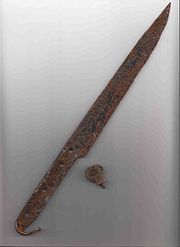Peasant Guard
| Peasant Guard | |
|---|---|

|
|
| Information | |
| Weapon type: | knife |
| Designations: | Peasant Army, Long Knife |
| Use: | weapon |
| Region of origin / author: |
Europe , peasant class |
| Distribution: | Europe |
| Overall length: | up to about 80 cm |
| Weight: | about 1 kg |
| Handle: | Wood, metal |
| Lists on the subject | |
The peasant guard or house guard is a typical weapon of the common people in the Middle Ages and early modern times , which was particularly widespread in the 15th and 16th centuries.
The peasant guard is also known as a chopping knife or long knife , although these terms are sometimes described several times in the literature with slightly different contents.
Peasant Guard
Often referred to simply as a knife in contemporary sources, it was considered a weapon of the people and was sometimes used iconographically to depict classes and professions such as farmers and wagoners , whereas weapons such as daggers and swords were regarded as symbols of status for nobles and patricians. Nevertheless, there were very valuable specimens that can also be found in the possession of high nobility. The boundary to tools is fluid in the peasant army. Characteristic are a single-edged, straight or saber-shaped blade and a wide hilt on which handle scales made of wood or horn are riveted. A simple bracket between the tang and the blade, which was called a nail at the time , often served as hand protection . Peasant fighters were particularly popular in the Peasants' War of 1525 and could reach lengths of up to 80 cm. Related to these weapons are the so-called “long knives”, which played an important role in the fencing art of the Renaissance .
The term “Bauernwehren” also refers to simple peasant weapons such as war scythes , war forks and war flails .
Long knife
The long knife or long knife was a weapon in the late Middle Ages and the beginning of the Renaissance . Due to the privilege of the nobility to carry double-edged swords, the demand for a “civilian” defense weapon grew in increasingly self-sufficient cities. The long knife was a long version of the medieval peasant defense. It was about three feet long, weighed a kilogram or more, and had a back blade at the end of its curved blade. The long knife was mentioned in almost all historical fencing books and was identified there as an effective and popular weapon of the non-nobility. The shapes of the long knife were very different. In addition to the crossguard , it often had a defensive nail as an additional guard. Certain fencing techniques could also be performed with the defense nail.
Another name for this weapon is large knife .
This edged weapon is not to be confused with the long knife in North American history.
Cutting knife
The cutting knife (also large knife or long knife ) was initially a bourgeois , single-edged cutting weapon in the 15th and 16th centuries.
Similar to the house or peasant guard, due to the fact that every free man was allowed to carry a knife (in contrast to the sword ), there was also a development towards longer and longer copies. With increasing popularity, nobles also used this weapon.
The chopping knife differs from the Malchus in the shape of the handle . The hilt of Malchus is modeled on that of a sword, while the cutting knife has simple, riveted handle scales.
literature
- Ludwig Beck: The history of iron in technical and cultural-historical relation: The XVI. and XVII. Century. With 232 imprinted illustrations. 1893–95, F. Vieweg and Son, 1895, original from University of California
- Cornelia Herberichs, Manuel Braun (ed.): Violence in the Middle Ages: Realities, Imaginations. Wilhelm Fink Verlag, Munich 2005, ISBN 978-3-7705-3881-2
- Hermann Heimpel, Franz Bastian: The trade of the city of Regensburg in the Middle Ages . Verlag W. Kohlhammer, 1926, original from University of Michigan
- Martin Jahn: The arming of the Teutons in the older Iron Age from around 700 BC. Chr. To 200 n. Chr . C. Kabitzsch Verlag, 1916, original from University of Michigan
- Wendelin Boeheim : Handbook of the armory . Reprint d. Ed. Leipzig 1890, Fourier Verlag, Wiesbaden 1985, ISBN 978-3201002578
